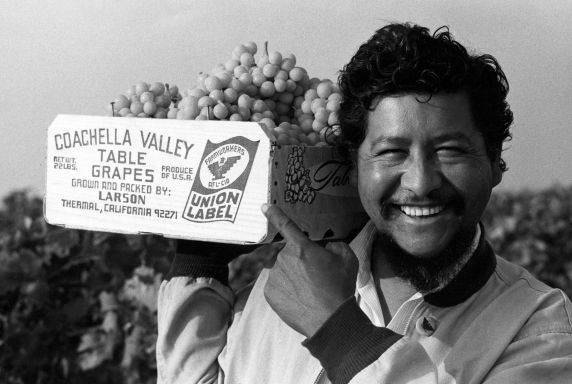They grew up during the Depression, inseparable and as close as brothers can be on their small family homestead in the North Gila River Valley outside Yuma, Ariz. When the family lost the farm, they became migrant farm workers and labored beside each other as children in California’s fields, orchards and vineyards in the 1930s and 1940s. By the early 1960s, Richard Chavez, then a journeymen carpenter, was dedicating most of his free time after work and on weekends helping his brother, Cesar Chavez, organize what would become the United Farm Workers of America.Richard Chavez spent the next three decades working full time with the farm worker movement. He passed away on July 27, 2011 at 81, of complications from surgery in a Bakersfield hospital.
Richard designed the stylized black Aztec eagle that later became the union’s world-renowned symbol in 1962. The next year, Cesar convinced Richard to put up his house as collateral for a loan to start a credit union for farm workers. In 1966, Richard gave up carpentry to dedicate all of his time to the movement, earning $5 a week like Cesar and other movement staff. He was the first full time staff person for the non-profit organization that is now the Cesar Chavez Foundation, providing extensive social services to farm workers.
Richard was born in 1929, two years after his brother, Cesar, on the family homestead near Yuma. The two brothers left farm labor in 1949, spending a year working together in lumber mills around Crescent City, Calif. In 1950, Richard moved back to San Jose, where in 1951 he entered the carpenters union apprenticeship program. He worked as a framer building suburban housing tracks before moving to Delano. There he worked on both commercial and residential projects, including schools and freeway overpasses. Richard began his activism with Cesar in the Community Service Organization, then the most effective Latino civil rights group in California, in 1952, and was president of the Delano CSO chapter, which he also helped form.
His varied duties with the UFW over the years included long stretches organizing the farm workers’ successful boycotts of California table grapes and other products in New York and Detroit during the 1960s and ’70s. He was in charge of administrating union contracts in 1970, and later negotiated UFW agreements and oversaw union bargaining. Richard was first elected to the UFW executive board in 1973. In the ‘60s and ‘70s, he also oversaw construction and helped build most of the major structures on the farm workers’ “Forty Acres” complex outside Delano, including its coop gas station, union office and hall, and health clinic.
Richard retired from the union in 1983, but always remained very active with the movement, fulfilling public speaking engagements and serving as an active board member of both the Cesar Chavez Foundation and Dolores Huerta Foundation. He also worked building and rehabilitating multi- and single-family housing, including affordable housing projects for the Chavez foundation, in the 1980s. He obtained his state contractors license and built a large housing community in Tehachapi and custom homes in Los Angeles during the 1990s. A dedicated researcher of his family’s history, Richard was the driving force behind a two-day Chavez family reunion that in October 2010 gathered more than 300 family members from across the nation and around the world at the National Chavez Center at Keene, Calif., where his brother is buried.
Viva Richard Chavez!

